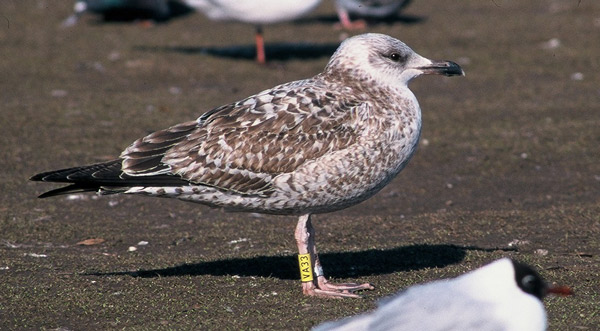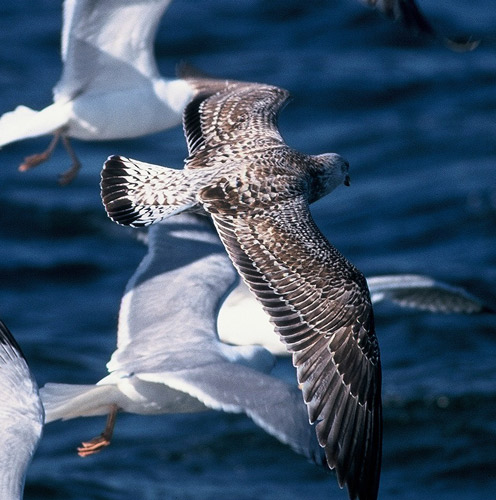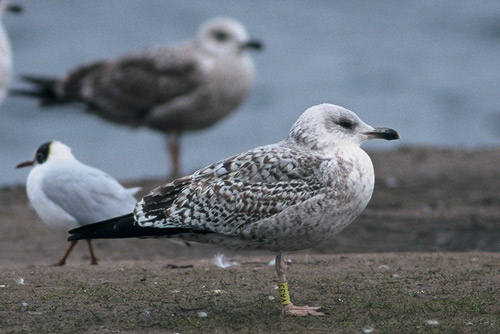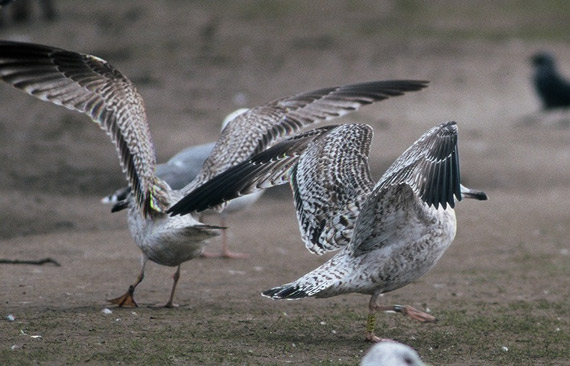 Herring Gull- Zilvermeeuw (argentatus & argenteus)
Herring Gull- Zilvermeeuw (argentatus & argenteus)
(last update:
Herring Gull plumages:
hg 1cy July
hg 1cy August
hg 1cy September
hg 1cy October
hg 1cy November
hg 1cy December
hg 2cy January
hg 2cy February
hg 2cy March
hg 2cy April
hg 2cy May
hg 2cy June
hg 2cy July
hg 2cy August
hg 2cy September
hg 2cy October
hg 2cy November
hg 2cy December
hg 3cy January
hg 3cy February
hg 3cy March
hg 3cy April
hg 3cy May
hg 3cy June
hg 3cy July
hg 3cy August
hg 3cy September
hg 3cy October
hg 3cy November
hg 3cy December
hg sub-ad January
hg sub-ad February
hg sub-ad March
hg sub-ad April
hg sub-ad May
hg sub-ad June
hg sub-ad July
hg sub-ad August
hg sub-ad September
hg sub-ad October
hg sub-ad November
hg sub-ad December
hg ad January
hg ad February
hg ad March
hg ad April
hg ad May
hg ad June
hg ad July
hg ad August
hg ad September
hg ad October
hg ad November
hg ad December
|
Herring Gull 2cy VA33 (argentatus), Denmark and Finland. Pictures from Denmark by Frank Abrahamson. Here are some pictures of an interesting Gull, which was ringed as so-called "first-winter" bird in Denmark (year 2001), ringed by Kjeld Tommy Pedersen. It was seen and photographed as 2cy bird in Lappeenranta, SE-Finland on October 13 2001. Thereafter it was again photographed in Denmark, as second-winter in March 2002. Especially as first winter bird, it much resembled the taxon michahellis, but as it was read in Lappeenranta, VA33 was identified as Herring Gull. It's easy to imagine the ID-problems as it’s a very tricky bird and it’s really interesting, especially considering the moult score that can be found in this bird. This is a first clue for identifying the bird. Many thanks to Kjeld Pedersen, Hannu Koskinen and Frank Abrahamson.
These kinds of birds are tricky to identify either michahellis or argentatus, and maybe it’s best to leave some of them unidentified. However, there are enough clues to positively identify this bird VA33 as Larus argentatus argentatus from the Baltic region and not a Larus michahellis: especially so when considering the pictures of the 3cy plumage in spring (March 2002 in Denmark). It remains to be seen whether you can fully exclude hybrid birds from michahellis x argentatus brood, there seem to be no objection to label this bird 100% argentatus. VA33 as 2cy in March In general, 1cy michahellis (July - November) have a noticeable advanced post-juvenile moult, which includes some wing-coverts and tertials, although definitely not in all michahellis. To have an idea about variation in replaced second-generation wing-coverts, have a look at the 1cy michahellis section. Looking closer at yellow VA33, it appears to lack any such second-generation wing-coverts or tertials. Some of the lesser coverts, especially in the upper visible rows in the folded wing seem to be fresher, but those feathers are not recently replaced second-generation feathers. These feathers were covered and protected by the above lowest row of lower scapulars and subsequently have maintained their darker centres in better conditions. The image below (image 2) shows VA33 with open wings and it’s clear that the outer median coverts and outer lower lesser coverts have been shed very recently, probably indicating that the complete moult has started (arrow 3a in the large image). Competing over food, some birds may loose single feathers. Considering its only March, one may wonder if it’s too early for argentatus and could indicate michahellis?
The exact start of the moult may be difficult to establish in the field, so still-images are needed (as is shown excellent image 2 by Frank Abrahamson). Regarding the start of moult, this may vary from year to year, probably corresponding with location and temperatures. In the Netherlands, year 2000 had relatively high numbers of argenteus Herring Gulls starting wing-covert moult in March. Year 2001 showed lower numbers. The fact alone that moult has started in March probably doesn’t exclude argentatus. The open wings in the above image show clearly the lack of second-generation wing-coverts in VA33, moulted in the post-juvenile moult. On this site you'll find images from 2cy January and April michahellis. Two images (January here, April here) are rather average in moult pace and sequence. These birds both show second-generation wing-coverts, which were moulted in the partial moult last autumn (see arrows 2d, 4d, 4e & 4f in the large image). Such feathers are typical for michahellis and to a lesser extend to western Lesser Blacked-back Gull graellsii/intermedius, but rare in argenteus/argentatus. As can be seen in image of 2cy michahellis from April, the second-generation wing-coverts moulted last in line look already more adult-like than earlier required coverts. So what are the positive characteristics for argentatus? A few clues can be found in the scapular region, as can be seen in image 1: VA33 has the second generation scapulars still with dark centres, very dark brown, almost blackish (arrow 1a in the large image). The white fringe on the tip of the old feather has worn away; nevertheless the centre is still dark, hardly bleached. It’s hard to find really old scapulars with worn fringes in VA33, the partial autumn moult (post-juvenile moult) was commenced late in the season. The same can be said about the wing-coverts. The central and outer wing-coverts in VA33 and in most January and April michahahellis are all juvenile. However, the condition of the feathers differ considerable with VA33 showing nice white fringes on the central greater coverts (arrow 3b in the large image), where most michahellis show wear on the fringes and the tips of the juvenile greater coverts. An obvious difference between michahellis and argentatus can be found in the moult pace of the lower scapulars. Arrow 1b in the large image points to the last moulted lower scapulars (three upper lower scapulars) in VA33 with arrows 1c and 1d indicating the juvenile scapulars (almost all the feathers in the two lower rows of scapulars), which are still present by March. It’s hard to find 2cy michahellis with the complete rows of lower scapulars still present by March, consisting of juvenile feathers. Arrow 2a in the large image shows the rear lowest scapular as the last moulted scapulars (with a white fringe) in michahellis. A few inner lower scapulars are missing (arrow 2c) but in general this January michahellis lacks any juvenile scapular. This can be compared with the April michahellis, where all the juvenile scapulars are clearly replaced. This bird shows the average moult in April michahellis with about 15% third generation scapulars. VA33 has a narrow tail-band, somewhat reminiscent of michahellis, combined with dark outer greater coverts. However, the tail pattern of VA33 is not exactly in line with the pattern of juvenile michahellis. In michahellis, the sub-terminal band is wedge-shaped, broad in the central tail-feather (just reaching the upper-tail coverts) and very narrow (just a single line) in the outer tail-feather (R6), especially on the outer-web. Moreover, R6 lacks any barring except this sub-terminal band (in Mediterranean and Atlantic michahellis), R6 appearing very white based. VA33 has a broader black sub-terminal band and barring on R6, but this oke for (eastern) michahellis? VA33 as 3cy in March
As 3cy bird, VA33 shows obvious points indicating it’s argentatus and not michahellis. The recently replaced scapulars still show a ginger tone just above the anchor blade sub-terminal band (arrow 5a in the large image). There are a few more of these pretty fresh scapulars, easily recognized by the broad white fringe on the tip. 2cy Michahellis has extensive partial moult in September, and these replaced feathers are still obvious in spring in the folded wing as can be seen in both pictures. Picture 6 (from January) shows a –weak and injured- 3cy michahellis with the complete median covert bar (arrow 6e in the large image), three inner greater coverts (arrow 6d) and randomly some lesser and lower lesser coverts (arrow 6c) replaced. In many michahellis, these feathers are obvious grey, or at least grey based. Such adult-like grey feathers, very common in 3cy michahellis, are pointed out by arrow 8b in the picture from May (the large image). VA33 completely lacks any grey adult-like feathers.
The pattern in the greater coverts is another indication VA33 being argentatus. Juvenile greater coverts in both michahellis and argentatus may be pretty dark, especially in the outer tract. This can be seen in image of VA33 with juvenile outer greater coverts (arrow 3b in the large image). However, the second-generation greater coverts are slightly different with argentatus showing silvery grey deep notching (image 8 or arrow 5c in the large image), where most michahellis shows fine, vermiculated barring (arrow 8c in the large image). Hybrid argenteus x michahellis 3cy in April that I have seen (examples in the mystery gulls section) had the second-generation greater coverts vermiculated barred as well, which might be an indication VA33 being a genuine argentatus.
The inner primaries of VA33 (image 8) are different than in michahellis. Michahellis normally has no extensive pale patches on the outer-webs of the inner primaries. The second-generation primaries in michahellis have paler inner-webs (up to p8 in some birds), but the outer-webs remain brownish black, contrasting with the greyish inner-webs. Last points are very clear in the most images of 3cy michahellis: the head and under-parts of michahellis have been replaced in the spring moult, birds appearing very white on head and breast. Only a minority of argenteus Herring Gull moult these feathers in early spring, with most 3cy argenteus showing a white head by June and still streaked headed in April. I have no substantial figures about Scandinavian argentatus; but maybe someone know of snow-white heads and under-parts in 3cy argentatus by April? So, most proably VA33 is no Larus michahellis, rather a Baltic Larus argentatus argentatus with some michahellis characteristics. But I didn’t see the bird in the field and therefore there may be features I missed. The circumstances in the field may have given observers a completely different idea about the identity this bird. |




